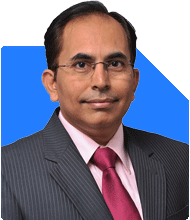Ramalingam Kalirajan |9736 Answers |Ask -Follow
Mutual Funds, Financial Planning Expert - Answered on May 01, 2024
He has an MBA in finance from the University of Madras and is a certified financial planner.
He is the director and chief financial planner at Holistic Investment, a Chennai-based firm that offers financial planning and wealth management advice.... more

Hello Sir. In Jan 2025, I'll receive a lumpsum of Rs 11L from one of my prior investment. I want to put this money in mutual funds. My horizon is 10 years. I want this corpus to be used for child college education. Please suggest how to go for it.
Goal Clarity: Define the expected expenses for your child's college education, factoring in tuition fees, living expenses, and other related costs. This will give you a clear target to aim for with your investment.
Risk Tolerance Assessment: Assess your risk tolerance to determine the appropriate allocation between equity and debt funds. Since you have a 10-year horizon, you can consider a relatively aggressive approach with a higher allocation to equity funds for potentially higher returns.
Diversified Portfolio: Build a diversified portfolio by investing in a mix of equity and debt mutual funds. Equity funds can provide growth potential, while debt funds offer stability and capital preservation.
Asset Allocation: Allocate a significant portion of the lump sum towards equity funds to harness the potential for long-term capital appreciation. You can consider allocating the remainder to debt funds to provide stability and mitigate downside risk.
Regular Review: Monitor the performance of your mutual fund investments regularly and rebalance your portfolio if needed to maintain your desired asset allocation.
Tax Efficiency: Consider tax-efficient investment options such as Equity Linked Savings Schemes (ELSS) for equity investments and Tax-Saving Fixed Deposits or Debt Funds for debt investments to optimize tax benefits.
Systematic Withdrawal Plan (SWP): As your child's college education approaches, consider setting up an SWP from your mutual fund investments to meet the educational expenses systematically while continuing to benefit from potential market growth.
By following these steps and staying disciplined with your investment strategy, you can work towards building a corpus that will support your child's college education aspirations over the next decade. It's always advisable to consult with a Certified Financial Planner to tailor the plan according to your specific circumstances and goals.
You may like to see similar questions and answers below
Omkeshwar Singh | Answer |Ask -Follow
Head, Rank MF - Answered on Apr 25, 2022
Omkeshwar Singh | Answer |Ask -Follow
Head, Rank MF - Answered on Jul 18, 2022
Ramalingam Kalirajan |9736 Answers |Ask -Follow
Mutual Funds, Financial Planning Expert - Answered on Jun 25, 2024
Ramalingam Kalirajan |9736 Answers |Ask -Follow
Mutual Funds, Financial Planning Expert - Answered on Jul 23, 2024
Nayagam P P |8829 Answers |Ask -Follow
Career Counsellor - Answered on Jul 15, 2025
Nayagam P P |8829 Answers |Ask -Follow
Career Counsellor - Answered on Jul 15, 2025
Patrick Dsouza |1295 Answers |Ask -Follow
CAT, XAT, CMAT, CET Expert - Answered on Jul 15, 2025
Janak Patel |58 Answers |Ask -Follow
MF, PF Expert - Answered on Jul 15, 2025
Nayagam P P |8829 Answers |Ask -Follow
Career Counsellor - Answered on Jul 15, 2025
Nayagam P P |8829 Answers |Ask -Follow
Career Counsellor - Answered on Jul 15, 2025
Nayagam P P |8829 Answers |Ask -Follow
Career Counsellor - Answered on Jul 15, 2025
Samraat Jadhav |2385 Answers |Ask -Follow
Stock Market Expert - Answered on Jul 15, 2025
Mihir Tanna |1067 Answers |Ask -Follow
Tax Expert - Answered on Jul 15, 2025
Radheshyam Zanwar |5395 Answers |Ask -Follow
MHT-CET, IIT-JEE, NEET-UG Expert - Answered on Jul 15, 2025



























